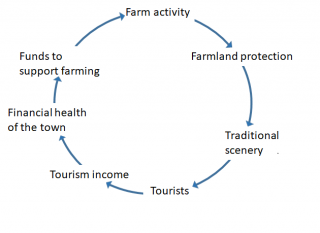
Community development with Junko Edahiro's "Hop, Step, Jump!" approach

Ko-junkan no machizukuri! (The Virtuous Cycle of Community Development) Japanese edition only
The president of the Institute for Studies in Happiness, Economy and Society (ISHES), Junko Edahiro, has assisted many community development efforts around Japan. In April 2021, she published a new book, entitled "Ko-junkan no machizukuri!" (The Virtuous Cycle of Community Development), in which she summarizes the essence of her approach. In this month's issue of the ISHES Newsletter she shares her ideas about the three-step "Hop, Step, Jump!" process, the key to her approach to community development. (Hop, step, jump is also referred to in track and field sporting events as the triple jump, or the hop, skip and jump.)
*****
I have assisted many communities with their visioning and development efforts. Often when observing a community I realized I have seen something similar before. It is very common to witness a response at the level of "This is the problem," quickly followed by "Let's take this strategy." People may say the problem is that the local supermarket is closing, or that houses are being left empty, so they jump to a conclusion, "Let's take this action." But often the problem is actually just a symptom of other problems. In many cases, the pattern of just looking at the symptoms and asking "What should we do about that?" ends up simply treating the symptoms, and that in itself can give rise to new problems.
So, what should we do? We need to slightly resist the urge to come up with a quick solution to "the problem," and think about the big picture first. To do so we need to consider two things: "What situation do we really seek?" and "Why is it not that way now, what is the underlying structure?" After that, we can think about specific actions or projects. I refer to this three-step process as "Hop, Step, Jump!"
Step 1 (Hop): Use backcasting and visualize the desired future of your community
The first thing to do is create a vision. Once the vision is set, you can tell if you are moving in the desired direction or going a little off track, and you can move ahead without going off course.
When creating your vision, you can create significant change with the backcasting approach, which starts by imagining the desired future state. To do so, first, you think about a certain point in the future. For example, if you want a vision that's in line with the Sustainable Development Goals, you would choose 2030, the target year for the SDGs. Then, you can freely imagine the future you want in 2030. You can write your thoughts down on sticky notes. Things like "I would love to see this situation in 2030..." Or "I hope the community will be like this..." In this way you can build an original vision for that community.
It is important for this to be a shared vision, in the sense that it has been developed by everyone together. The key point here is not just the vision as an output, but the shared process that produces the vision. Every community will have people with a variety of ideas, thinking, and approaches to things. That is why it's important to look at the same guiding star, and rise above small differences between people. The shared vision serves as your guiding star. Thus, to develop a shared vision, the ideal is to bring together members that represent as many groups as possible within the community in terms of gender, age group, neighborhood, and sector, etc.
The first community vision initiative I supported was in Ama Town, Shimane Prefecture, in southwestern Japan. It has often been referred to as a model of local community revitalization. About three hours by ferry off the coast of Japan's main island of Honshu, Ama Town is on Nakanoshima, one of the Oki Islands. It has a population of about 2,350 and is a thriving farming and fishing community.
But even though it was seen as a success story, Ama Town still faced a challenge. That is, a generational change in the town's leadership. Ama Town decided to set up a community-based committee of people of the next generation who could work together to promote community development. This Committee for Creating the Ama of Tomorrow (dubbed "Asu-Ama") was launched in March 2015.
How did they recruit members? Seeking people from the community and municipal offices, they called for "men and women from their 20s to 40s who have the passion not only to develop strategies but also to make them come true." This age range was chosen in order to reach the people who would have a role in community development for the next generation. A total of 20 persons came forward from the municipal offices and youth section of the local chamber of commerce, including 11 from the private sector (from various sectors, such as fisheries, agriculture, food services, construction, education, and social services) and nine from local government departments (including general affairs, industry, construction, social services, and education).
Step 2 (Step): Use systems thinking to visualize the underlying structures
"Systems thinking" is the concept that the phenomena we observe are made up of various interlinked components. Some things in the world are visible, and some are not. We won't do so well if we develop strategies based only on what we can see. This is because what we can see is just the tip of the iceberg. Below that is an interconnected structure of many things that we cannot see from the surface.
What can we do to make the invisible become visible? Below is one example of a loop diagram, often used in systems thinking.
A loop diagram is something that displays the elements of causes and effects. As an example, here is a storyline for one loop diagram. A decline in the health of the farm sector increases the amount of abandoned farmland. Then, traditional landscapes and scenes will disappear. If that happens, fewer tourists will come to visit, and tourism revenues will drop. If that happens, the town's finances will worsen. If that happens, there will be less money available to support farming.
In this story you can identify aspects that increase or decrease. These are our variables. In above example, the variables would be farm activity, abandoned farmland, traditional scenery, tourists, tourism income, financial health of the town, and funds to support farming. Next, these variables are joined with arrows going from causes to effects.

This is how we can consider the structures that have created the current patterns in the community.
Loop diagrams are useful because they enable broad and deep thinking about a community's situation, rather than just looking at what is visible in front of you. With this tool you might discover that what you thought was a "problem" was really just a symptom of the problem. By thinking more broadly, you may discover that completely different strategies can be effective.
Step 3 (Jump): Design and implement your community development project
At this point it is time to think about projects and implement them. No matter how wonderful your vision, or how widely and deeply you analyze the structures of the community, nothing will change if you don't take action.
In the case of Ama Town, the Committee for Creating the Ama of Tomorrow ("Asu-Ama") developed the "Asu-Ama Challenge Plan" based on the future vision for the community and loop diagram analysis. Based on this plan, the municipal government developed a "Comprehensive Strategy for Ama Town Revitalization" and is currently moving ahead with various initiatives based on the comprehensive strategy.
In addition, each member of Asu-Ama made a declaration of "What I will do for this vision." Even after the term of the Asu-Ama committee ended, members continue to meet from time to time to report on the progress of their own projects and share advice.
When I visited Ama Town, I participated in one such gathering. I was impressed when everyone sat in a circle around the loop diagram, which had been created through considerable effort, and the members spoke with such enthusiasm as they shared their observations. They talked about what their efforts had already changed in this structure, and by how much. What discoveries they had made in the process of taking action. And what needs to be done in the future.
On the theme of "utilizing latent local resources in Ama" as identified using the loop diagram, members from a fisheries cooperative are now promoting the use of fisheries resources that were previously not being used. They are now working on a new fish processing project based on the idea of harvesting types of fish that were not previously being sold on the market. These fish are caught using a fixed-net (teichi-ami) technique, a sustainable, community-based, and traditional style of fishing. They are moving ahead with various other initiatives and developing new products, such as processing the smaller horse mackerel being caught into packages of bite-sized pieces of dried fish, serving fried small horse mackerel at the ferry terminal restaurant (gateway to Ama Town), and developing products such as canned "al ajillo" (a Spanish-style condiment) from other seafoods that were not being used previously.
*****
In this way, through the creation of a shared vision (hop) and an understanding of the underlying structures (step), the project is then executed (jump). This is all based on a future vision of the community and its own unique structures. We are no longer just treating symptoms. Initiatives all moving in the same direction are organically linked and can empower even bigger transformations. I hope that the "Hop, Step, Jump!" approach to community development based on systems thinking can be an inspiration for community development where you live too.




